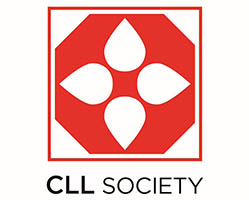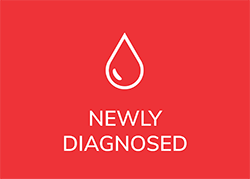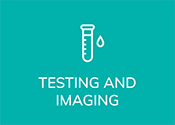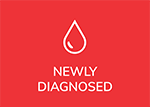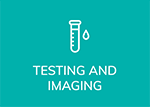MONTHLY QUIZ: CT scans should be used in CLL:
- At time of diagnosis to establish a baseline.
- Before starting any treatment to assess staging.
- After treatment to assess response.
- Only in combination with a PET scan to assess both anatomy and the metabolic activity of any nodes or masses.
- While they may be needed in some circumstances, outside of a clinical trial there is no mandatory role for CTs.
The correct answer is #5. While there are many circumstances where a CT may be helpful, their routine use with diagnosis or treatment is not generally indicated. PET scans measure metabolic activity and are used to look for a second cancer such as Richter’s Transformation (RT). RT is more metabolically active than CLL and therefore will “light up” on a PET scan. Sometimes a CT is needed before starting venetoclax to assess “tumor burden” that helps determine the risk of tumor lysis syndrome (see March’s Bloodline). Outside of clinical trials, CT and PET scans are not helpful in the routine management of our CLL. For more details, see: http://cllsociety.org/beyond-the-basics/what-about-ct-scans/. MRI can be used sometimes instead of CTs. They use no ionizing radiation so they may be safer when many scans will be needed.
NEWS: The PAN Foundation’s CLL assistance fund is currently open and accepting applications. Eligible patients can receive up to $3,250 in financial assistance to help with your deductibles, copays, and coinsurance costs associated with your CLL treatment. For reference, the full URL is: https://www.panfoundation.org/disease-funds/chronic-lymphocytic-leukemia/.
Join CLL Society and Plexus Communications for our webinar on July 8th, Noncovalent BTK Inhibitors New Targeted Options for Relapsed or Refractory Chronic Lymphocytic Leukemia with Drs. Matthew Davids and Brian Koffman.
Join CLL Society for our virtual event on July 24th, Ask Me Anything – Featuring Dr. Richard Furman and Jeff Folloder.
At EHA last month, Dr. Koffman spoke on a CLL expert panel to >1200 hematologists from 65 countries. Also at EHA, 2 new BTK degraders (NX-5948 and BGB 16673) demonstrated promising results offering new options even when patients had failed both covalent (ibrutinib, acalabrutinib and zanubrutinib) and noncovalent BTK inhibitors (pirtobrutinib). Trials are open.
With COVID-19 on the rise, Pemgarda is the only PrEP (Pre-Exposure Prophylaxis) authorized now but it can be hard to find a nearby infusion center. This locator link helps. Sipavibart from AstraZeneca designed to replace Evusheld is not yet authorized.
BASICS: Response to Therapy: In order to be consistent, researchers have agreed on standard ways to describe response to therapy. The definitions are quite technical. If you are in a trial or on treatment, ask about your response status. We go from worst to best:
- Progressive disease (PD): As the name states, the CLL continues to grow despite therapy. This is not good news.
- Stable disease (SD): The cancer neither progresses nor recedes. This can be a durable and an OK circumstance, especially if the CLL is not causing problems.
- Partial Remission (PR): The cancer has been knocked back, but there are still cancer cells to be found in the blood or marrow or nodes. PR requires at least a 50% reduction in the size of lymph nodes and in the number of lymphocytes in the peripheral blood stream. Some deep PR can last years.
- Complete Remission (CR): The absence of clonal lymphocytes in the blood is one of the major criteria. All lymph nodes need to be normal size (<1.5 cm). In a clinical trial, the confirmation of a CR usually requires a bone marrow biopsy that shows no CLL. There is ongoing debate as to whether the maximum size of a node that is still considered normal should be redefined to < 2.0 cm. CR does not mean the CLL is cured, but it’s a step in the right direction.
- Undetectable Meaurable (or minimal) Residual Disease (uMRD): This is the best news with the longest durations of response. Flow Cytometry can be used to find a single CLL cell hiding among 10,000 cells in the blood or bone marrow. Next generation sequencing (clonoSEQ) can find 1 cancer cell in a million. If no cells are found, you are uMRD, a very good thing. Just to confuse things, it is possible to be uMRD and be in a PR if your nodes are still enlarged. This happens when enlarged nodes don’t shrink back to normal size but are cancer free. Research is increasingly suggesting that achieving uMRD might be more important for progression free survival (PFS) than a CR. uMRD is also not a cure in most cases, but some researchers are thinking uMRD tests can be used to develop cures.
WORD OR ACRONYM OF THE MONTH: ALC: ALC stands for absolute lymphocyte count and is the only lymphocyte number that matters, and even it doesn’t matter that much. If the ALC is too high, CLL may be the diagnosis and a rapid rise in ALC (increase of more than 50% over a 2-month period or a lymphocyte doubling time [LDT] <6 months) may mean treatment is indicated. A high ALC on its own is not a reason to treat CLL. Ignore the lymphocyte percentage. It is not helpful in CLL management.
If the CLL Society has helped you or a loved one, please consider making a donation.
